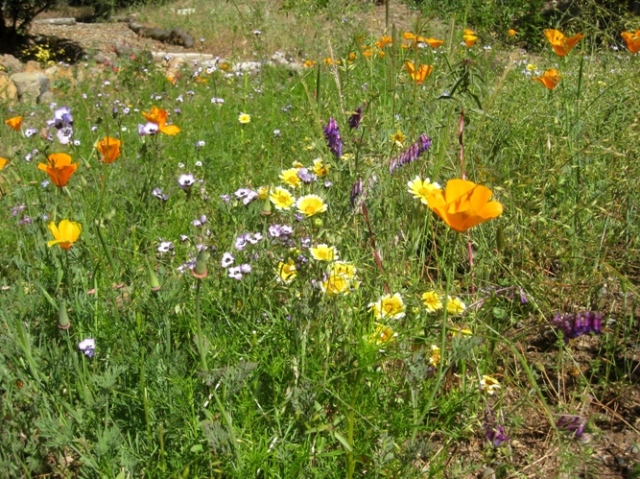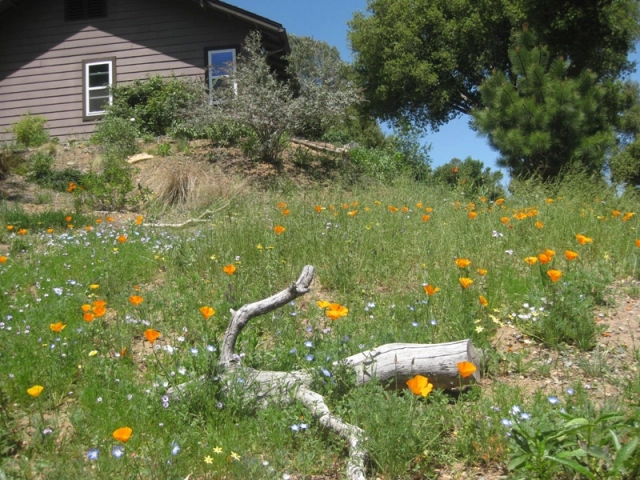The midsummer meadow
In early July, the meadow is at its peak and gives pleasure every day. Here are some of the advantages and realities of growing your own!
A CA Native seeded meadow is possible.
It takes some weeding.
The flowers are bright and grasses wave in the wind
Bare spots happen.
Seeds wash down hill sprout where they can.
Seeds spread where they can and more flowers pop up.
Meadows need little water and care if native seeds are used.
Meadows can fit into a garden with perennials.
Meadows are enjoyable for months of the year.
“Ah! How I long for the beautitude of a summer meadow-place
That calls me ever forward and slightly to the left
That begs of me to forget the stressful stresses of life.”
Slim Walter DeTurtlevain, Very Bad Poetry
Past the peak bloom-late July
This late afternoon, while watering, I noticed the last strong rays of sun glinting on the seedheads of the meadow. In mid summer, the last of the California poppies and Globe gilia have done and are forming seeds. A few Clarkia amoena hang in and the yarrow is at its peak. The vulpia grasses are golden brown as they’ve been all last month.
A few Clarkia amoena hang in and the yarrow is at its peak. The vulpia grasses are golden brown as they’ve been all last month.
Everything is drying quickly and I have a bit more mulch I’ll cover the bare ground with as the plants shrink and dry. I’ve been watering about every three days by hand, especially the new perennials around the edge.
Slender single shoots of blue-grey Blue flax, Linium lewisi, can be spotted here and there, most still only 6-10 inches tall. I few oxeye daises are sprouting and just sitting. The others I have bloomed long ago. These are behind the schedule, it seems.
An Artemisia grows nice and tall, upper right, even though it was transplanted last fall with the other ‘foundation plants’.
Hopefully the Yarrow will form patches and act as a kind of ground cover…it looks very meadowy and next year the new plants should bloom with existing yarrow which bloomed along with the Globe gilia. That is something to look forward to.
Some Heermann’s tarweed has snuck in and I’ve removed all but a few. They can stay to add color in October, but I’ll take them out before they go to seed. It’s kind of fun to ‘manage’ the existing natives to my liking and make them behave a bit. The tarweeds’ peak performance is in the Fall and will be everywhere except the close garden and I enjoy the fields of them where they are, if you know what I mean.
One thing I enjoy about the meadow at this time is that it blends so well with the surrounding native vegetation already here. It may look the same, grassy and becoming golden, but I know there are more surprises to come in this part of my garden.
You don’t have to understand Life’s nature,
then it becomes a grand affair.
Let every day just of itself occur
like a child walks away from every hurt
and happens upon the gift of many flowers.Rainer Maria Rilke (1898)
***
The Meadow project, month by month
What am I really doing in the garden in October? Planning and removing weeds
Do you dream of a natural and beautiful wildflower meadow? Finding and sowing seeding
Let’s check for progress on the meadow! Weeding and watching the weather
How to weed a meadow in the Sierra Foothills More weeding…letting the sprouts thrive
Let’s check on Fall and Winter projects! Identifying seedlings
The wildflower meadow in May Small triumphs
My California native meadow in June Starting to bloom
The midsummer meadow The peak bloom
Stomping down the Autumn meadow Neatening up
Native California meadow in the second year
Recent Posts
How to Be a Lazy Gardener
...and still have a pretty garden With a busy household and jobs, we are…
Summer is Spring at Whiskey Falls!
Take a day trip to Whiskey Falls... Come visit Whiskey Falls and the surrounding high…
California oak acorns: Feast or famine
Why do oaks drop more acorns some years and not others? If you have live…
Mule’s ear and Farewell to Spring
Roadside treasures worth stopping for In the first week of July in the Sierra foothills…
Our favorite butterfly plants
Wow! Butterflies love these plants! Grow any of these for instant results and each is…
A water-saving veggie garden for the foothills
Your water-wise veggie garden Does everyone in our Mountain Community grow at least one tomato?…


